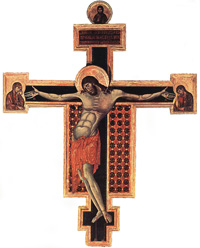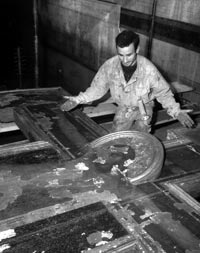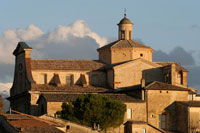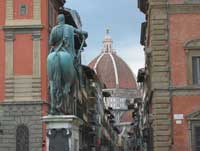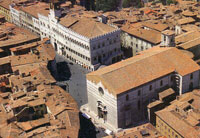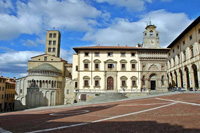| |
|
 |
|
|
[1] Cimabue, or Bencivieni Di Pepo was the last great Italian artist in the Byzantine style, which had dominated early medieval painting in Italy. Among his surviving works are the frescoes of New Testament scenes in the upper church of S. Francesco, Assisi, the “Santa. Trinita Madonna” (c. 1290, Uffizi, Florence); and the “Madonna Enthroned with St. Francis” (c. 1290–95, lower church of S. Francesco).
Cimabue's style provided the firm foundation upon which rested the art of Giotto and Duccio in the 14th century, although he was superseded in his own lifetime by these artists, both of whom he had influenced and perhaps trained. His great contemporary, Dante, recognized the importance of Cimabue and placed him at the forefront of Italian painters. Giorgio Vasari, in his Lives of the Most Eminent Italian Painters, Sculptors, and Architects (1550), begins his collection of biographies with the life of Cimabue. Art historiographers from the 14th century to the present have recognized the art and career of Cimabue as the dividing line between the old and the new traditions in western European painting.
The earliest biography of Cimabue, by Vasari, states that he was born in 1240 and died in 1300. The dates can only be approximations, for it is documented that Cimabue was aliveand working in Pisa in 1302. The only other document relative to his life identifies him as a master painter and witness to a document signed in Rome in 1272. From this it can be concluded that he was born prior to 1251. Other documents indicate that he was christened Bencivieni di Pepo, or Benvenuto di Giuseppe in modern Italian. Cimabue was a nickname that through an error later became a family name.
Nothing is known of his early training. Vasari's assertion thathe was apprenticed to Greek Byzantine painters living in Italy is probably an attempt to explain both the style and the sudden emergence of this genius. He was certainly influenced by the Italo-Byzantine painter Giunta Pisano and by Coppo di Marcovaldo and may have been an apprentice to Coppo.
Cimabue's character may be reflected in his name, which canperhaps best be translated as “bullheaded.” An anonymous commentator in a work on Dante written in 1333–34 said that Cimabue was so proud and demanding that if others found fault with his work, or if he found something displeasing in it himself, he would destroy the work, no matter how valuable. It is perhaps significant that in the Divine Comedy Dante places Cimabue among the proud in Purgatory. And the poet refers to him to illustrate the transience of earthly fame: “Cimabue thought to hold the field in painting, and now Giotto hath the cry.” But pride in his own accomplishments and a high personal standard of excellence separated Cimabue from the anonymous artists of the Middle Ages.
Only Cimabue's last work, the mosaic of “St. John the Evangelist,” in the Duomo of Pisa, is dated (1301–02). The large “Crucifix,” in S. Domenico, Arezzo, is generally accepted as his earliest work and datable before 1272. The frescoes in the upper church of S. Francesco, Assisi, were probably executed between 1288 and 1290. The period 1290–95 includes the large “Crucifix” for Sta. Croce in Florence—about 70 percent destroyed in the floods of 1966, though restoration has been completed; the “Sta. Trinita Madonna,” an altarpiece now in Florence's Uffizi; and the “Madonna Enthroned with St. Francis,” in the lower church of S. Francesco at Assisi.
Despite the small number of Cimabue's works that have survived, they fully support the reputation that the artist has acquired. In certain formal or more “official” commissions, such as crucifixes and large altarpieces, Cimabue adhered closely to the formal vocabulary of the Byzantine tradition. And yet he breathes new emotive content into the abstract or stylized forms. In the fresco cycle at Assisi, Cimabue found an especially receptive patron, for the art commissioned by the Franciscans from Cimabue's time on is generally characterized by a dramatic and emotive narrative.
Along with the traditional stylization of the human form, Cimabue seems to have been among the first to return to a close observation of nature. In a highly formal altarpiece such as the “Sta. Trinita Madonna,” he introduces at the baseof the throne four prophets who are modelled through light and dark in a highly sculptural manner that seems far in advance of its date. Cimabue seems also to have been one of the first to recognize the potentialities of painted architecture, which he introduced into his scenes to give an indication of place and a heightened sense of three-dimensionality. The fresco “The Four Evangelists,” in the vault of the crossing of the upper church at Assisi, is sculpturally conceived, but its solidity and bulk are heightened by the crystalline city views that accompany each of the figures. The view of Rome that accompanies St. Mark, for example, is not only one of the earliest recognizable views of the city but is also one of the first in which the buildings seem solid and separated one from the other by a clearly defined space. This concern with the illusion of space and with a three-dimensional form occupying that space is rarely met with in medieval painting prior to Cimabue, but it is highly characteristic of Cimabue's leading student and rival, Giotto.
In Cimabue's more formal works he follows tradition closely, but he brings to that tradition a heightened sense of drama. After him the Byzantine tradition in Italy died out, partly because it had been superseded by a new style, but also because he had exhausted all the possibilities inherent in the tradition. In his less formal works he was able to exploit agrowing interest in narrative that had been inherent in the Byzantine tradition but never fully developed. Finally, he brought to Italian painting a new awareness of space and of sculptural form. By his own personality and by his contributions to painting he merits Vasari's characterization of him as the first Florentine painter and the first painter of “modern” times.
John R. Spencer (Encyclopaedia Britannica)
[2] The church of San Domenico, with its Gothic architecture, commands the slope of Piazza San Domenico, one of the most fascinating corners of the city. Founded in 1275 by the Tarlati di Pietramala family, it was finished at the beginning of the fourteenth century, although it has undergone renovations and destructions over the centuries. The unusual façade, with a small porch, opens through a lovely Romanesque portal that still conserves a fresco by Angelo di Lorentino in the lunette. The interior consists of a single luminous nave, with modern windows and open-beam roofs; the fourteenth and fifteenth century frescos that decorate the walls are of particular interest. Starting from the inside of the Front façade, the sequence includes the Crucifix by Parri di Spinello, Saint Philip and Saint Jacob and stories from their lives by Spinello Aretino, and a wooden Crucifix of the fifteenth century. Along the right wall the artistic documents include: Saint Catherine of Alexandria by Parri di Spinello, Saint Anthony and Saint Francis by the school of Piero della Francesca, the Dragomanni or Dragondelli altar, a Gothic tabernacle of pietra serena by Giovanni Fetti (1350) and a Madonna and Child by Spinello (1408). The left wall includes: a Crucifix and Annunciation attributed to Giovanni d'Agnolo di Balduccio, the Stories of Saint Jacob and Saint Christopher by Spinello, and San Vincenzo Ferreri by Lazzaro Vasari, great grandfather of Giorgio. Several interesting works are conserved in the presbytery: a stone Madonna and Child that may come from one of the gates in the city walls, a sculpture of the Sienese school of 1339, an Annunciation by Spinello, and the Tomb of bishop Ranieri degli Ubertini, who died in 130l, an example of Sienese art of the fourteenth century. However, the protagonist of this church is the Crucifix above me main altar, a superb work by Cimabue in his youth, one of the first examples where the iconography of Christ on the cross abandons the abstract Byzantine theme to study the human sentiments.
[Pamela Zanieri, A guide to the places of Piero della Francesca, Firenze : Scala, [2007], p 70]
|
|
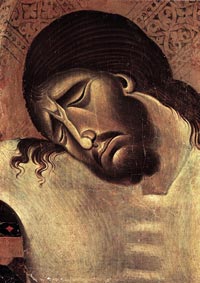
Cimabue, Crucifix (detail), 1268-71, tempera on wood, 336 x 267 cm, San Domenico, Arezzo
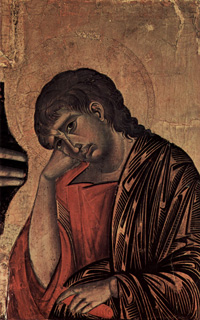
This detail shows St John, as represented at the end of the right arm of the cross
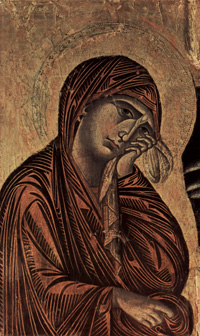
This detail shows the Madonna, as represented at the end of the left arm of the cross
|
 |
|
|
The Kunsthistorisches Institut in Florence | The Flood of 1966 | Santa Croce | Cimabue’s Crucifix
This dramatic event in the recent history of the city of Florence is portrayed in the online exhibition based on the comprehensive inventory of the photo library. Significant is that the photographs are much more than mere witnesses of the catastrophe. The photographic eye reveals unexpected perspectives of the devastation and losses. The stunned amazement and horror of the observer of the destructive forces of nature are expressed in these photographic works.
The photographer Ivo Bazzechi, who took most of the photographs exhibited here, recorded his impressions during the flood. The photographs record the situation during and after the catastrophe, in which immense damage was inflicted on streets, plazas, buildings, and works of art. In particular, the primary aim of the collection of photographs shown here is to highlight the damage and destruction inflicted on works of art, such as those in the Santa Maria Novella and Santa Croce churches, or inflicted on individual works, such as the almost completely destroyed Crucifix by Cimabue. The symbol of the devastating effects of the flood is the almost complete destruction of the huge Crucifix by Cimabue. The crucifix, painted in distemper on wood (around 1272) by one of the most significant painters of the 13th century, had lost the majority of its layer of paint. The first action taken was to move this work of art from the former Santa Croce refectory to the Limonaia in the Giardino di Boboli. In 1976, the Crucifix underwent a major restoration, during which it was possible to conserve the remains of the layer of paint.
The exhibition in the Kunsthistorisches Institut documents the flood’s immediate aftermath and the ramifications for the city and its artistic treasures. The first section depicts the damage and destruction suffered by the works of art themselves. The second selection illustrates the devastation of the city and its streets, alleys, squares and houses.
The majority of the exhibition’s 80 photographs, taken by Ivo Bazzechi, date from the dramatic days following the flood.
|
|
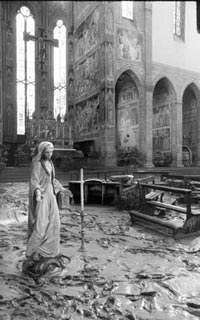 Interior of the Basilica of Santa Croce,
6 Nov 1966
|
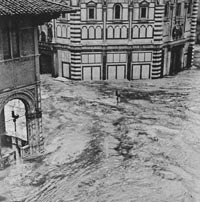
View onto the Baptistery and the Loggia del Bigallo (Photographer Bazzechi) |
|
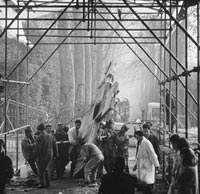
Transportation of the crucifix to the
limonaia of the Giardino di Boboli
(Photographer Bazzechi) |
|
|
| |
|
|
|
|

|
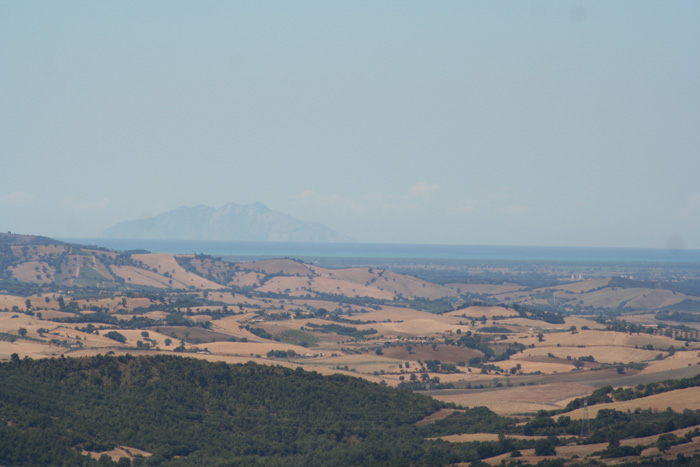 |
The location of Podere Santa Pia is unique and the landscape a once-in-a-life sight. Although this is off the beaten track it is the ideal choice for those seeking a peaceful, uncontaminated environment.
|

Holiday accomodation in Tuscany | Podere Santa Pia | Artist and writer's residency
|
| |
|
|
|
|

. |
|
|
Podere Santa Pia |
|
Podere Santa Pia, garden view, December |
|
View from terrace with a stunning view over the Maremma and Montecristo |
| |
|
|
|
|
|
|
|
|
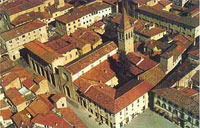
|
Montefalco |
|
Piazza della Santissima Annunziata
in Florence |
|
Sansepolcro |
| |
|
|
|
|
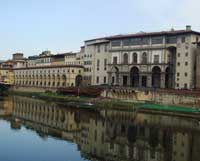
|
|
|
|
|
Vasari Corridor, Florence |
|
Perugia |
|
Arezzo, Piazza Grande |
| |
|
|
|
|
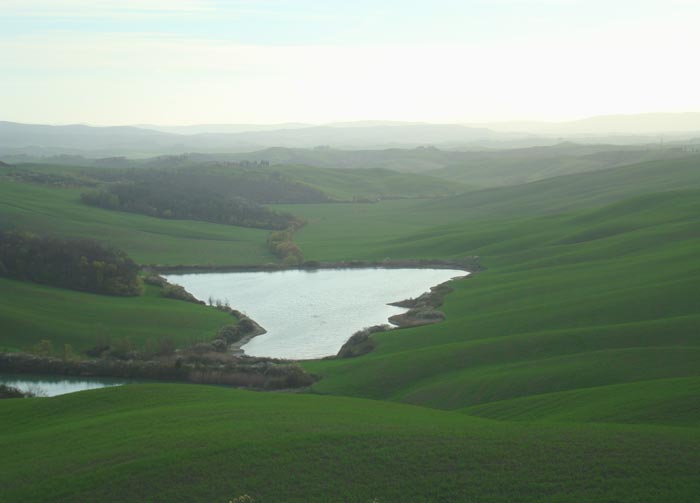 |
Crete Senesi, surroundings of Podere Santa Pia
|
| |
|
|
|
|
|
|
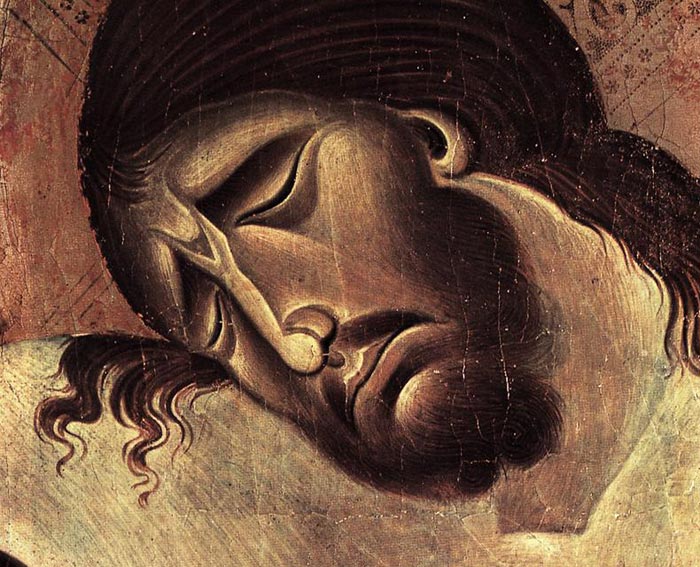
 Interior of the Basilica of Santa Croce,
Interior of the Basilica of Santa Croce, 



